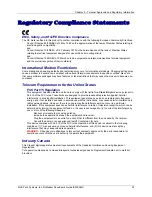
Chapter 1 – RJModem Hardware
Multi-Tech Systems, Inc. RJModem Developer's Guide (S000363I)
11
Pin
Signal
Name
IN/OUT
Type
Description
8
TXCLK O
Transmit Data Sync Clock
. TX synchronous data clock for sync data mode. More
information below.
9
–TXD I
Transmitted Data
. The DTE uses the –TXD line to send data to the module for
transmission or to transmit commands to the module. The DTE should hold this circuit in
the mark state when no data is being transmitted or during intervals between characters.
10
–RXD O
Received Data
. The module uses the RXD line to send data to the DTE and to send
module responses to the DTE. In command mode, –RXD data presents the module
responses to the DTE. Module responses take priority over incoming data when the two
signals are in competition for –RXD. When no data is transmitted, the signal is held in
mark condition.
11
CLK
Optional 28.224 or 27 mhz clk input (requires special build option)
12
GND GND
Logic Ground
.
13
SPKR
Speaker
. Call Progress signaling on MT5656RJ is a square wave output that can be
optionally connected to a low-cost single-ended speaker; e.g., a sounducer or an analog
speaker circuit.
14
RXCLK O
Receive Data Sync Clock
. RX synchronous data clock for sync data mode. More
information below.
Transmit Clock (TXCLK) and Receive Clock (RXCLK)
Transmit Clock (TXCLK) and Receive Clock (RXCLK) pins are used in synchronous (sync) mode serial
communication. They are needed when using a synchronous terminal device to keep synchronization between the
modem and the terminal device on the serial port. Transmit Clock (TXCLK) and Receive Clock (RXCLK) are not used
in asynchronous mode.
However, most applications use asynchronous mode because synchronous ports are not as common as
asynchronous ports on computer hardware.
For asynchronous operation the host system does not need to
connect to the TXCLK and the RXCLK pins on the RJModem; you can use a 9-pin interface.
Synchronous mode can be set with the
&M
command and stored with the
&W
command. See the RJModem AT
command guide available on the RJModem Developer Kit CD and the Multi-Tech Web site.
&Q – Sync/Async Mode
Description:
This command is an extension of the &M command and is used to control the connection modes permitted. It is
used in conjunction with S36 and S48.
Note:
When &Q0 to &Q3 are issued to select the mode, the subsequent
connect message will report the DCE speed regardless of the W command and S95 settings.
Syntax:
&Q<value>
Defined Values:
<value>
Decimal number corresponding to the selected option.
0
– Selects direct asynchronous operation. The value 000b is written to S27 bits 3, 1, and 0, respectively.
See &M0.
1
– Selects synchronous connect mode with async off-line command mode. The value 001b is written to
S27 bits 3, 1, and 0, respectively. See &M1. (Serial interface operation only.)
2
– Selects synchronous connect mode with async off-line command mode and enables DTR dialing of
directory 0. The value 010b is written to S27 bits 3, 1, and 0, respectively. See &M2. (Serial interface
operation only.)
3
– Selects synchronous connect mode with async off-line command mode and enables DTR to act as
Talk/Data switch. The value 011b is written to S27 bits 3, 1, and 0, respectively. See &M3. (Serial
interface operation only.)
5
– The modem will try to negotiate an error-corrected link. The modem can be configured using S36 to
determine whether a failure will result in the modem returning on-hook or will result in fallback to an
asynchronous connection. The value 101b is written to S27 bits 3, 1, and 0, respectively. (Default.)
6
– Selects asynchronous operation in normal mode (speed buffering). The value 110b is written to S27 bits
3, 1, and 0, respectively.
Result Codes:
OK <value> = 0 to 3, 5, or 6
ERROR
&W – Store Current Configuration
Description:
Saves the current (active) configuration (profile), including S-Parameters, in one of the two user profiles in
NVRAM as denoted by the parameter value. This command will yield an ERROR message if the NVRAM is not
installed or is not operational as detected by the NVRAM test.
The current configuration is comprised of a list of storable parameters illustrated in the &V command. These
settings are restored to the active configuration upon receiving a Zn command or at power up (see &Yn).
Syntax:
&W<value>
Defined Values:
<value>
Decimal number corresponding to the selected profile.
0
– Store the current configuration as profile 0.
1
– Store the current configuration as profile 1.
Result Codes:
OK <value> = 0 or 1.
ERROR
Otherwise.












































